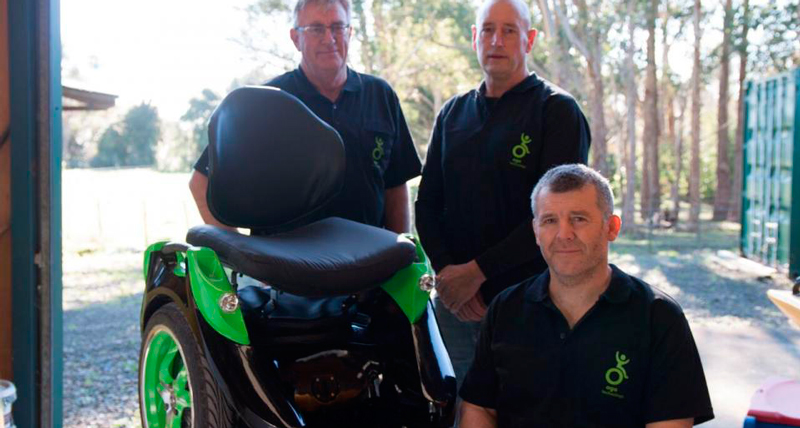Kevin Halsall’s invention, called the Ogo, is expected to change millions of lives worldwide and is set to start production in September.
Kevin, an inventor and product designer from Otaki in Kapiti, has built a revolutionary personal mobility device not just for his friend, paraplegic Marcus Thompson, but for 11,000 New Zealand users and 70 million worldwide who rely on a wheelchair for mobility.
Kevin’s unique patented invention, called the Ogo, blends active moving seat control with self balancing technology which frees the user’s hands to do anything they want.
“It’s given another dimension of mobility to my life,” says Marcus, a secondary school teacher, who broke his back in a high speed skiing accident.
The Ogo hasn’t just pleased Kevin and Marcus. It won the 2016 New Zealand Innovators’ Award for design and engineering and, in 2015, the first model received the BCC (Building Clever Companies) Innovative grand prize of $10,000.
Since then Kevin has refined the Ogo to become a multi-purpose machine that will further enrich the lives of people with disabilities but also be an asset to able bodied commuters, sportspeople, retirees, tourist operators and the business community.
Now with the final prototype tested and completed, Kevin’s business is tooling up for production.
Kevin’s interest in helping Marcus began about six years ago. They’d known each other for several years and Marcus had taught Kevin’s two daughters, Erina and Della. Both Kevin and Marcus enjoyed field archery where contestants move through bush and rough terrain to shoot at 28 targets.
Kevin observed Marcus struggling in his conventional wheelchair and exhausting his energy and stamina before the competition was over. As a designer, innovator and problem solver, Kevin’s challenge was to make it easy for Marcus. His research led him to a Segway, a self-balancing, battery powered electric vehicle which has censors in its base.
These sensors enable the driver to move forwards or backwards by shifting their weight in the direction they want to move. Kevin realised these same concepts could be applied to a personal mobility device.
He spent hundreds of hours over six years experimenting until he designed and manufactured a sturdy machine that could be manoeuvred by the body, leaving the hands free to do whatever the driver wanted.
“Inspired by self balancing technology, I produced an active, moving seat control, operated by upper body mobility and core muscle strength,” Kevin said. “When the driver leans forward so does the machine, when he or she leans back, it reverses. When they lean to the side, it swivels in the new direction.”
“It’s very intuitive to use. To go in any direction, they simply move their body or use the handgrips.”
The Ogo provides the driver with free hand and arm movement. They can do something as functional as holding a cup of coffee in one hand, opening a door with the other and moving through to another room or outside.
In Marcus’s case, he can carry and move objects, power along the undulating beach at up to 20 kph and, in particular, mow his lawns. “’I’ve been frustrated for so long but I can do things I haven’t done for years,” he says. “It’s therapeutic and healing for the soul. With my hands free, I’m able to use my whole body to carry out tasks again.”
However to add extra safety and security, the Ogo comes complete with a thumb controlled joystick. By activating a switch, it locks the left and right movement of the seat and transfers the steering control to the joystick for a more conventional feel.
The machine has been endorsed by occupational therapists who maintain that driving the Ogo with the upper body provides the exercise it needs. People with disabilities from around the world have travelled to Otaki, tested the machine and placed an order.
“When I asked them ‘what do you think’ they have all said Ogo’s capabilities have exceeded their expectations,” Kevin says.
Since launching Ogo on to the market in May, orders have been flooding in. Kevin has received thousands of expressions of interest and 30 plus orders. Business Manager, Stuart Ayres, is currently talking to investors, business leaders and agents, both in New Zealand and overseas, so the machine can be available globally.
“This is revolutionary for people not just with disabilities but the commuting public around the world. It will change lives,” Stuart says.
While Kevin initially focused on the disability community he saw the advantages of Ogo for people in the office, on the street, at the beach, in undulating terrain and for tourism businesses including cruise line passengers who can use Ogo to explore ports of call.
“For those with disabilities, it frees up the hands, vital for musicians, film makers and camera people and will enhance the performance of golfers, tennis, hockey and basketball players and a host of other sports that both disabled and able bodied athletes enjoy.”
“This is the start of a whole new way of looking at personal mobility devices and we’re committed to being at the forefront of their development and technology.”




